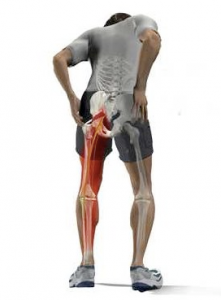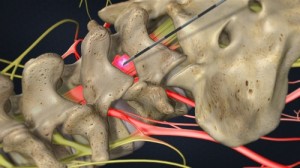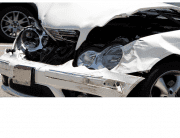by Dr. Demitri Adarmes
Lumbar radiculopathy is the medical term for what is commonly known as sciatica. Sciatica or lumbar radiculopathy results from mechanical irritation of one of the nerve roots in the lumbar spine and most typically presents as low back pain radiating into the buttock and/or into the  leg.
leg.
Causes of lumbar radiculopathy
Radiculopathy or irritation of a lumbar nerve root is usually caused by a herniated lumbar disc (also called a prolapsed or ruptured disc). The intervertebral discs are composed of an inner semi-fluid material enclosed in a cartilaginous outer ring. Normally, they act as cushions or shock-absorbers for compressive or rotational forces on the spine.
Increased compressive forces on the lumbar intervertebral discs occur with bending and lifting. Many years of cumulative stress can lead to small tears in the outer cartilaginous ring (called annulus). Eventually, these tears can progress to bulging of the disc or a complete rupture of the annulus (ruptured or herniated disc). A prominent disc bulge or a herniation of  the disc can impinge on one of the nerves exiting the lumbar spinal cord and cause radiculopathy (sciatica).
the disc can impinge on one of the nerves exiting the lumbar spinal cord and cause radiculopathy (sciatica).
Signs and symptoms of lumbar radiculopathy
Mechanical irritation of a lumbar nerve root can cause numbness and/or weakness of leg on the affected side. For example, irritation of the fifth lumbar nerve root typically presents with numbness or pain in the lateral (outside) lower leg and/or weakness of the ankle (which causes the foot to drag during swing phase of that leg). Irritation of the first sacral nerve root will produce numbness along the back of the leg down into the plantar surface of the foot and weakness of the calf muscles. Clinically, this will present with loss of ability to stand on the ball of the foot on the affected side.
On physical examination, the straight leg raise will be positive. This is where the patient lies in the supine position and the affected leg is raised from the table producing a shooting pain sensation from the back down into the leg. Decreased sensation to pinprick will be evident in the distribution of the affected nerve. Motor weakness will be present in the muscles innervated by the affected spinal nerve.
Treatment for Sciatica/Radiculopathy
Initial conservative treatment of lumbar radiculopathy consists of oral nonsteroidal anti-inflammatory drugs (e.g., ibuprofen) and bedrest. Physical therapy is prescribed for strengthening exercise of the abdomen and lumbar spinal muscles. For intense pain, oral narcotics are often required. Lumbar epidural steroid injections which have a powerful
anti-inflammatory effect on the irritated nerve root can be beneficial.
Surgery is reserved for unrelenting symptoms and significant neurologic impairment (e.g., leg weakness). A decompressive discectomy removes any disc material impinging on the lumbar nerve root. Alternatively, the minimally invasive intralaminar microendoscopic lumbar discectomy can be performed.







Leave A Comment